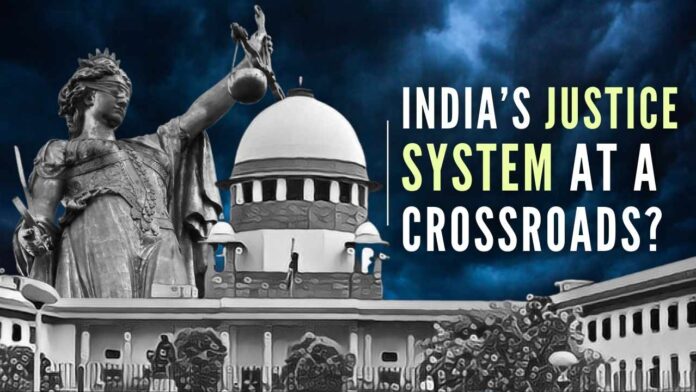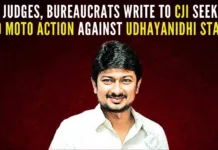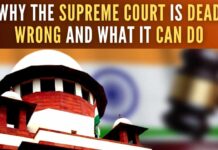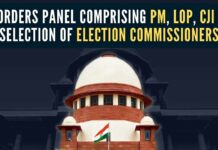
“Honorable” must remain honorable in their deeds and legal opinions
India’s democracy is under attack not only because of the left-leaning media, the Jihadi mindset of many, the opposition political parties, and like but the spectacle played out in the courtroom of two Supreme Court Justices Surya Kant and Pardiwala on July 1. The latter is being recanted in print and social media and even among retired judges, military officers, IASs, etc[1] [2]. Clearly, the unjustifiable verbal commentary by these justices has exposed the judiciary’s unacceptable conduct and attitude. We discuss a few relatively less well-known facts about the Supremo Collective (another variation on SC) of justices which may explain their current behavior and past practices of overreach only to serve themselves in many cases.
I don’t have a legal background but am disappointed in India’s apex court because of their whimsical approach to offering justice. People come to the SC for justice after exhausting all other legal avenues with the hope that SC judges will hold a much higher bar for ethics, objectivity, and impartiality. The following three examples may explain why and/ or how the SC has failed to deliver.
The Code of Conduct
The first puzzle is why India’s Judiciary has not accepted the 2002 Bangalore Principles of Judicial Conduct (BPJC)[3]. Interestingly, this document was a result of a conclave of learned members of judges, judiciary, and academics from all over the world held in Bangalore (now Bengaluru) and yet India is not a signatory even twenty years later.
This 11-page document (and a companion detailed commentary – 153 pages[4]) enumerates six cardinal principles of the Code of Conduct, called values. It will be an insult to the honorable justices to define the commonsense values beyond the statement clarifying why and how these values are essential and/ or pre-requisite for the judiciary.
Independence
A pre-requisite to the rule of law and a fundamental guarantee of a fair trial. A judge shall therefore uphold and exemplify judicial independence in both its individual and institutional aspects.
Impartiality
Essential to the proper discharge of the judicial office. It applies not only to the decision itself but also to the process by which the decision is made.
Integrity
Essential to the proper discharge of the judicial office.
Propriety (including the appearance of propriety)
Essential to the performance of all of the activities of a judge.
Equality
Ensuring equality of treatment to all before the courts are essential to the due performance of the judicial office.
Competence and diligence
Pre-requisites to the due performance of the judicial office.
Why the SC has refrained from adopting BPJC and affirmed that the Indian Judiciary upholds all the values. Was the then SC in disagreement with the values and that mindset continues to date? Could it be their attitude that the SC Justices are above the law and/ or wanted to establish their supremacy? Did SC not want to be bound by a Code of Conduct? Only the Justices have the answers if ‘We the People of India,’ held them are answerable in the public court in 2022.
The collegium system
It is a “system,” under which appointments and promotion and transfer of the judges of the Supreme Court are decided which consists of the Chief Justice of India plus four of the senior-most judges of the Supreme Court[5]. All members of the collegium have equal power and authority. It should be noted that there is no mention of the collegium either in the original Constitution of India or in successive amendments.
Simply put, Articles 124 and 217 in the Constitution state that the judges of the Supreme Court and high courts are appointed by the President after consultation with others as the President may deem necessary for the purpose. It appears that the process may have not worked well. Consequently, the SC introduced a collegium system and argued that the “consultation” in the Constitution meant concurrence in appointments. I don’t know why the President accepted it.
At the present, the President appoints the SC Chief Justice which must be strictly by seniority and thus it is merely a procedural formality. All other judges in SC and high courts are recommended by a “group of five” consisting of the Chief Justice of India or High Court Chief Justices and four other senior judges, respectively. There is also a provision that I don’t fully understand which states, “the government has to give its assent to the names,” sent by the collegium.
To the best of my understanding, the collegium system makes the selection process circuitous, suspect, and contrary to what the Constitution mandates. In other words, the sitting senior judges in the high courts and Supreme Court wield a tremendous influence on who gets appointed and the President’s assent is more of a formality as appointing authority. The collegium seems like a close-knit club of judges with little or no input from retired/ experienced judges. Additionally, if the President has reservations about a given candidate recommended by the group of five, it goes back to them but in the end, only those recommended by the collegium are appointed.
This process has the potential of being unduly influenced by caste, gender, religion, etc., as well as favoritism and corrupt practices like political influence. For example, reportedly Justice Pardiwala has a history of questionable conduct while in Gujarat High Court but he got appointed anyway[6]. The only loophole is that President can delay giving his assent. In that case, many vacancies remain unfilled leading to a large number of pending court cases and thus a disservice to the people seeking justice. As noted below, the collegium system was ultimately subjected to transparency under RTI.
The RTI (Right to Information) Act
It was enacted to empower the citizens, promote transparency and accountability in the working of the government, contain corruption, and make democracy work for the people in a real sense. To my surprise, RTI has been reviewed by the SC numerous times shown in the 48-page compendium[7]. This shows the magnitude of the courts’ intervention, not necessarily all good or bad, in various instances and reaching verdict(s) to uphold the spirit of RTI or weaken it. The legal proceedings are notoriously lengthy and expensive with hundreds of pages long verdict and a layperson like me understand very little. However, here are a few important decisions about RTI worth citing.
One reported example is the SC judgment on the RTI Act setting a dangerously low bar for what passed muster as the law of land[8]. The SC delivered a judgment on the need to give a reason to file RTI in high courts. That has not only harmed the Act but the basic principle of legal reasoning.
Another SC judgment from a five-judge Constitution Bench directed the Central Public Information Officer (CPIO) of the Supreme Court to divulge information regarding the collegium decision-making[9][10]. It was held that all files, including correspondences between the Collegium and Union relating to the appointment of Justices H L Dattu, A K Ganguly, and R M Lodha should be made available under RTI. I assume it now applies to all collegium files and thus more transparency of the process if not necessarily the outcome. Likewise, a judgment about the transparency of the personal assets of judges was a landmark decision[11].
Returning to the question of the Indian judiciary being at a crossroads, I say yes. Undeniably, India’s judiciary is buried under a very heavy weight of caseloads. In part, we lack judges at all levels but also the judges on the seat are not fulfilling their obligation as is true in other government departments. In the legal system in India, I have seen firsthand, how easy it is to get the court clerk to extend the hearing date with a “convenience fee,” another name for bribery.
The public trust in the judiciary is at a low point for many reasons including widespread and continuing corruption in the courts, and the cases dragged on for years. The “cash” is still the king in courts, somewhat under the table but hardly reduced. The SC which I have called the Supremo Collective of honorable judges can and must set the appropriate code of conduct (not necessarily BPJA) and restore people’s trust that justice is rendered responsibly, objectively, and ethically. The “Honorable” must remain honorable in their deeds and legal opinions.
I argue that all judges must take a deep breath, analyze themselves critically, and make amends as necessary. The Chief Justice of India must approach the Legislative branch with the concurrence of the President to appropriate resources as the highest priority for more judges at all levels. A targeted approach to disposing off the age-old litigations in a judicious manner must be devised. The President must hold the judiciary accountable and expect the best and most judicious behavior at all times.
The citizens deserve the best from its judicial system being free from biases, political influences, and fair and objective based on facts, evidence, and the rule of law. The judiciary must rise above themselves for the collective good of the people of India. Even the recent upheaval caused by the commentary by the two Justices can be forgotten and forgiven if the justices gracefully agree, “to err is human” and the people of India equally gracefully follow, ‘to forgive is divine.”
In our collective responsibility-we, the people and the three-legged governance system including the judiciary, executive, and legislature must reengage, reengineer and reform judiciary to uphold India’s Constitution and trust in the rule of law.
Note:
1. Text in Blue points to additional data on the topic.
2. The views expressed here are those of the author and do not necessarily represent or reflect the views of PGurus.
Reference:
[1] Verdict without trial and verbal character assassination by the SC bench – Jul 02, 2022, PGurus.com
[2] Nupur Sharma Case: Supreme Court in the Age of Social Media – Jul 06, 2022, News 18
[3] THE BANGALORE PRINCIPLES OF JUDICIAL CONDUCT 2002 – ICJ
[4] Commentary on the Bangalore Principles of Judicial Conduct – UNODC
[5] What is Collegium System? Know about appointment of judges in India – Jan 29, 2021, Jagran Josh
[6] 58 MPs seeks impeachment proceedings against Gujarat High Court judge – Dec 18, 2015, Desh Gujarat
[7] COMPENDIUM OF SUPREME COURT/HIGH COURT DECISIONS ON RTI ACT, 2005 – DOP Jharkhand
[8] SC judgment on RTI Act sets a dangerously low bar for what passes muster as law of land – Apr 06, 2020, The Print
[9] Judgment in Plain English – SCO
[10] CENTRAL INFORMATION COMMISSION – SCO
[11] CENTRAL INFORMATION COMMISSION FACTS OF THE CASE – SCO
PGurus is now on Telegram. Click here to join our channel and stay updated with all the latest news and views
For all the latest updates, download PGurus App.
- Education and election in Bharat: Race to the top - April 16, 2024
- Kejriwal: “An Insignificant Man” or a corrupt politician with impending prison term - March 24, 2024
- Bharat’s general elections and the Model Code of Conduct - March 22, 2024











Our Judicial system is required to be re-engineered/rewritten to close many loop holes…. Many of the decisions/verdicts/observations are biased and politically influenced, as if the SC is a Supremo Collective of…..and not the Supreme Court. Our present Judiciary is under the control/clutches of “Super” Advocates working as mouth piece of corrupt political system….
Judiciary is expected to be “blind” but recent judgments have shown it to be highly influenced by political interests particularly those with Jihadi sentiments. India’s judiciary is in dire need of engineering and reforms as stated above. Thank you.
[…] Latest posts by Vijendra Agarwal (see all) Source link […]
Thank you. I will also read your article.
Excellent article. Judges and the president should read and reflect on and act.
Thank you; I am pleased that you appreciated it.
[…] Latest posts by Vijendra Agarwal (see all) Source link […]
Excellent article. Very well put with citations.
In fact, it appears that the author has tried to be politically correct, and said things mildly.
May I draw the readers’ attention to my article (https://www.pgurus.com/how-justice-delivery-system-can-be-improved/) on how the justice delivery system can be speeded up, and why it should be done quickly, 5 years back!